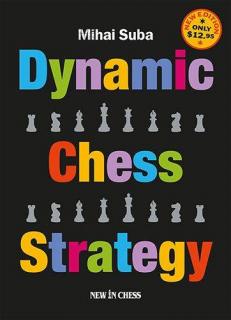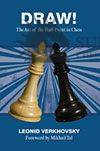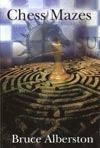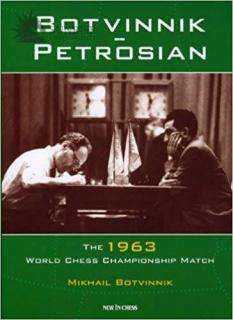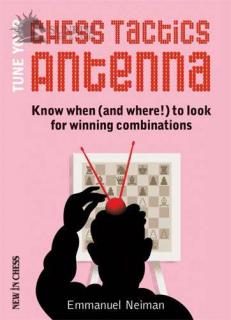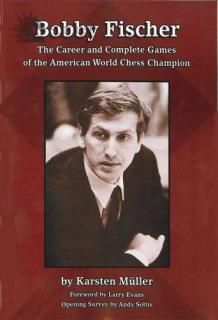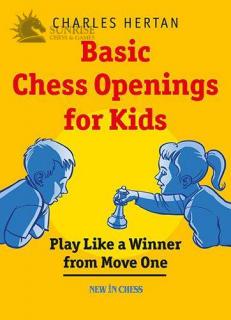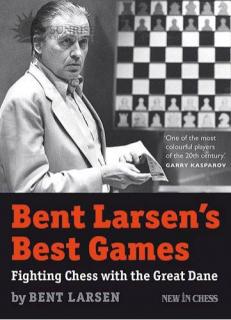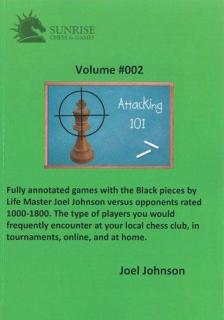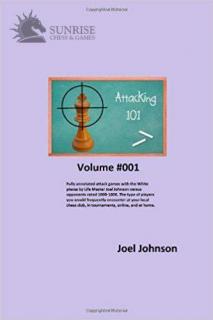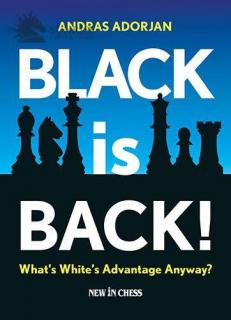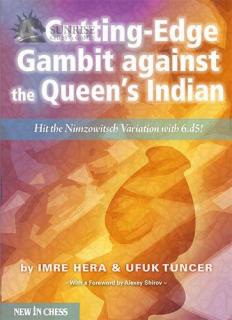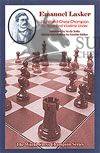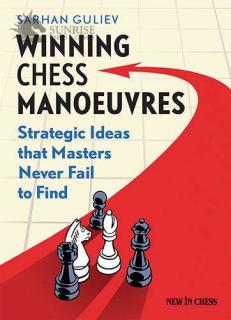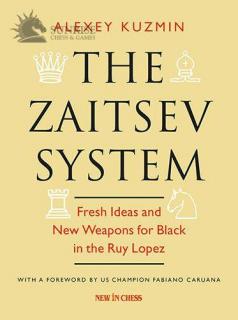Dynamic Chess Strategy: Low-priced Edition of a Modern Classic
In the battle of chess ideas, the publication in 1991 of Dynamic Chess Strategy was a defining moment. Before Mihai Subas exceptional book, chess writers had neglected one of the most important factors of a chess position: its dynamic potential. Suba demonstrated that the traditional concept of improving the position was often static and irrelevant, and that classical strategy, if applied dogmatically, can prevent you from finding the right plan and its subsequent moves. 'Dynamic Chess Strategy' won t
- Sklep: Sklep Szachowy: Szachy, Figury, Zegary, Książki, GRAWEROWANIE LASEROWE! - Polski Producent szachów e
- Cena: 57.00 zł
Draw! The art of the Half-Point in Chess
We have all seen games – and perhaps even played them – in which a difficult or lost game is salvaged by a brilliant drawing combination. In the early 1970s, Soviet International Master Leonid Verkhovsky collected some of the most fantastic draws ever played. You will be captivated by combinations and threats, as inexhaustible imagination in defense and attack counterbalance each other. The chess prowess of one player is basically in equilibrium with the mastery of his opponent. Both are playing for
- Sklep: Sklep Szachowy: Szachy, Figury, Zegary, Książki, GRAWEROWANIE LASEROWE! - Polski Producent szachów e
- Cena: 71.00 zł
Chess Mazes: Increase Your Piece Awareness by Seeing Ahead Further
A completely new kind of chess puzzle helps you develop the necessary skills to take your game to the next level. Excellent training to avoid one-move blunders. To master Chess Mazes you have to exert better control and command of the full potential of all your pieces and you have to visualize their movements in your mind's eye. This sounds more difficult than it is: Alberston's unique method takes you by the hand. Very good for beginners and improving chess players. With hundreds of exercises. Ameri
- Sklep: Sklep Szachowy: Szachy, Figury, Zegary, Książki, GRAWEROWANIE LASEROWE! - Polski Producent szachów e
- Cena: 71.00 zł
Botvinnik-Petrosian
World Chess Champion Mikhail Botvinnik writes the story of the 1963 match in which he lost his title to fellow Russian Tigran Petrosian. Botvinnik, one of the greatest chess players of all time, analyses the games, reveals his match strategy and comments on the strategic choices of his opponent. Botvinnik?s revealing essay: ?Why In lost the match? is counterbalanced by Petrosian?s analysis of his win, which is also included in this important historical document. A fascinating and highly instructive report
- Sklep: Sklep Szachowy: Szachy, Figury, Zegary, Książki, GRAWEROWANIE LASEROWE! - Polski Producent szachów e
- Cena: 95.00 zł
Tune Your Chess Tactics Antenna
If only life was as straightforward as a book of chess exercises! If only someone would tap you on the shoulder every time the moment to show your tactical skills has arrived! However, the reality is that during a game you are on your own. Nobody will whisper in your ear when you have reached a position that is, in fact, a tactical puzzle and all you have to do is solve it. Emmanuel Neiman offers help. He has identified a number of signals that tell you that somewhere in the position you are looking at
- Sklep: Sklep Szachowy: Szachy, Figury, Zegary, Książki, GRAWEROWANIE LASEROWE! - Polski Producent szachów e
- Cena: 118.00 zł
Bobby Fischer PAPERBACK
CHESS Magazine: One of the Best Books of 2009 The Ultimate Fischer Collection! The years after the Second World War saw international chess dominated by the Soviets – Botvinnik, Smyslov, Tal, Petrosian and then Spassky held the world crown, treating it as if it were almost an integral part of their heritage. There were occasional flashes of brilliance in the West – Reshevsky, Najdorf, and later Larsen – but no one really mounted a serious challenge to the Soviet hegemony. Then, in the mid-1950s, a lo
- Sklep: Sklep Szachowy: Szachy, Figury, Zegary, Książki, GRAWEROWANIE LASEROWE! - Polski Producent szachów e
- Cena: 151.00 zł
Basic Chess Openings for Kids
Award-winning author Charles Hertan knows what kids really need to know (and want to know) about getting their pawns and pieces ready for action. Traditional chess opening books concentrate on the variations in different openings. Charles Hertan believes that for beginners and advanced beginners memorizing lines is not only boring but also a waste of time. Hertans approach is different. He helps kids to develop a solid understanding of the fundamental opening principles. What are the properties of
- Sklep: Sklep Szachowy: Szachy, Figury, Zegary, Książki, GRAWEROWANIE LASEROWE! - Polski Producent szachów e
- Cena: 90.00 zł
Bent Larsen´s Best Games
Bent Larsen (1935-2010) was one of the greatest fighters chess has ever seen. In his rich career the great Dane defeated all World Champions from Botvinnik to Karpov and he became one of the most successful tournament players of his time. Bent Larsen's uncompromising style and his unorthodox thinking made him popular with chess players all around the globe. In 1967/1968 Larsen won five international elite events in a row, a truly spectacular achievement. His successes were such that Bobby Fischer let
- Sklep: Sklep Szachowy: Szachy, Figury, Zegary, Książki, GRAWEROWANIE LASEROWE! - Polski Producent szachów e
- Cena: 142.00 zł
Attacking 101 Volume #002: 110 Fully Annotated Games
The goal of the books in this series Attacking 101 is to provide detailed analysis of my own attack games played against lower rated players. The players are all rated in the range of 1000 to 1800 - the types of players you would frequently encounter at your local chess club, local tournaments, online, and at home. They make the same errors you regularly witness in your games but here you get to see a Chess Master dissect and exploit the moves, show why they are wrong, and how to punish the opponents poo
- Sklep: Sklep Szachowy: Szachy, Figury, Zegary, Książki, GRAWEROWANIE LASEROWE! - Polski Producent szachów e
- Cena: 71.00 zł
Attacking 101 Volume #001: 60 Fully Annotated Games
The goal of the books in this series Attacking 101 is to provide detailed analysis of my own attack games played against lower rated players. The players are all rated in the range of 1000 to 1800 - the types of players you would frequently encounter at your local chess club, local tournaments, online, and at home. They make the same errors you regularly witness in your games but here you get to see a Chess Master dissect and exploit the moves, show why they are wrong, and how to punish the opponents poo
- Sklep: Sklep Szachowy: Szachy, Figury, Zegary, Książki, GRAWEROWANIE LASEROWE! - Polski Producent szachów e
- Cena: 71.00 zł
Black is Back
Many chess players act intimidated and overly cautious when they have the Black pieces. They are so preoccupied with Whites advantage of the first move, that their predominant urge is to defend against possible threats and to safeguard their position. With his iconoclastic Black is OK books, Andras Adorjan has consistently been fighting this negative mindset. In Black is Back!, the Hungarian grandmaster continues his crusade. Adorjan shows that Whites advantage is far from obvious and that winning wi
- Sklep: Sklep Szachowy: Szachy, Figury, Zegary, Książki, GRAWEROWANIE LASEROWE! - Polski Producent szachów e
- Cena: 109.00 zł
A cutting-Edge Gambit against the Quneen's Indian
The ultra-sharp pawn sacrifice 6.d5 has caused a revolution in the 4… Ba6 line of the Queens Indian Defence in recent years. The ingenious gambit was hotly debated at the highest level by players like Alexey Shirov, for White, and Peter Leko, for Black. At club level it became a dangerous weapon for attackers. Hungarian grandmaster Imre Hera and Turkish FIDE master Ufuk Tuncer have charted this topical line and analysed it deeply. They give a clear overview of the history of the line and have thoroug
- Sklep: Sklep Szachowy: Szachy, Figury, Zegary, Książki, GRAWEROWANIE LASEROWE! - Polski Producent szachów e
- Cena: 95.00 zł
Emanual Lasker, Second World Chess Champion
'One of the Best Chess Books of 2010': Magazine Chess (UK) Emanuel Lasker was a great chess fighter, thinker and researcher. He was possessed of gigantic playing strength, retaining the title of World's Number One Chessplayer for 27(!) years. Even after losing his crown, he kept his ability for a long time, as shown by his victories and prize-winning finishes in immensely powerful international tournaments when he was 54 (Moravska-Ostrava 1923), 55 (New York 1924), 56 (Moscow 1925), and even at 66 (Mos
- Sklep: Sklep Szachowy: Szachy, Figury, Zegary, Książki, GRAWEROWANIE LASEROWE! - Polski Producent szachów e
- Cena: 109.00 zł
Winning Chess Manoeuvres: Strategic Ideas that Masters Never Fail to Find
When a chess master finds a winning strategic idea it is seldom by accident. An amateur, staring at a position on the chess board is often fumbling in the dark, his head spinning with a multitude of general rules and vague notions. The masters approach is concrete. He knows how and where to look, because he has studied the games of other masters. In this book, grandmaster Sarhan Guliev presents a wide range of strategic manoeuvres that have been repeatedly employed by great chess players. He shows how
- Sklep: Sklep Szachowy: Szachy, Figury, Zegary, Książki, GRAWEROWANIE LASEROWE! - Polski Producent szachów e
- Cena: 118.00 zł
The Zaitsev System: Fresh Ideas and New Weapons for Black in the Ruy Lopez
The Zaitsev System is one of the most dynamic setups for Black in the ever popular Ruy Lopez chess opening. When Alexey Kuzmin joined the coaching staff of World Champion Anatoly Karpov in the 1980s he started analysing the Zaitsev System, and later continued his investigations as a second of Alexander Morozevich. For this book he has updated and improved his analysis, and found countless innovations that change the assessments of many lines. One of the drawbacks of the Zaitsev, some feel, is that Whit
- Sklep: Sklep Szachowy: Szachy, Figury, Zegary, Książki, GRAWEROWANIE LASEROWE! - Polski Producent szachów e
- Cena: 133.00 zł
